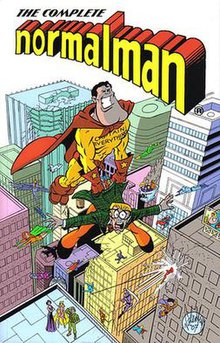
The Legion of Doom is a group of supervillains who originated in Challenge of the Superfriends, an animated series from Hanna-Barbera based on DC Comics' Justice League. The Legion of Doom has since been incorporated into the main DC Universe, appearing in comics, as well as further animated and live-action adaptations, and also video games.

The Legion of Super-Heroes is a superhero team appearing in American comic books published by DC Comics. Created by writer Otto Binder and artist Al Plastino, the Legion is a group of superpowered beings living in the 30th and 31st centuries of the DC Comics Universe, and first appeared in Adventure Comics #247.
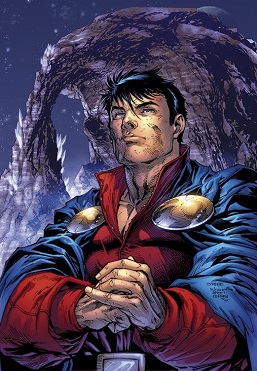
Lar Gand, known mainly as Mon-El, is a superhero appearing in American comic books published by DC Comics, commonly in association with the Legion of Super-Heroes, Superboy, and Superman. The character has been reinterpreted over the years, but in all versions serves as a hero with abilities similar to those of Superman, sometimes serving as a substitute for him.
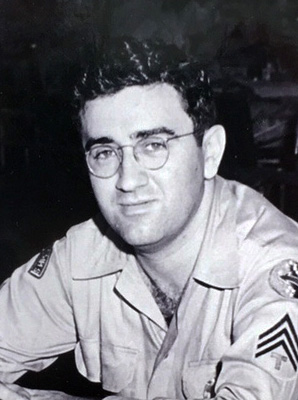
Jerome Siegel was an American comic book writer. He is the co-creator of Superman, in collaboration with his friend Joe Shuster, published by DC Comics. They also created Doctor Occult, who was later featured in The Books of Magic. Siegel and Shuster were inducted into the comic book industry's Will Eisner Comic Book Hall of Fame in 1992 and the Jack Kirby Hall of Fame in 1993. With Bernard Baily, Siegel also co-created the long-running DC character The Spectre. Siegel created ten of the earliest members of the Legion of Super-Heroes, one of DC's most popular team books, which is set in the 30th Century. Siegel also used pseudonyms including Joe Carter and Jerry Ess.
The Legion of Substitute Heroes are a group of fictional characters in the future of the DC Comics universe. The "Subs", as they are often called, are rejected Legion of Super-Heroes applicants who band together to prove that their powers are not as useless as they claim. They first appeared in Adventure Comics #306, and were created by Edmond Hamilton and John Forte.
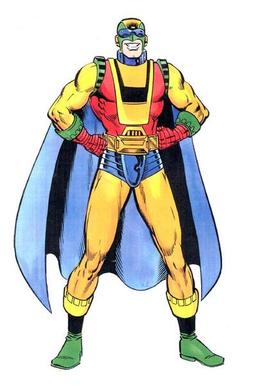
Captain Ultra is a superhero appearing in American comic books published by Marvel Comics. Created by Roy Thomas, George Pérez, and Joe Sinnott, the character first appeared in Fantastic Four #177. Captain Ultra has been a member of the Revengers at various points in his history.

Jim Valentino is an American writer, penciler, editor and publisher of comic books, best known for his 1990–1992 work on Guardians of the Galaxy for Marvel Comics, and for co-founding Image Comics, a company publishing creator-owned comics.
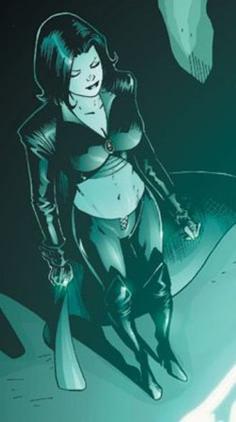
Shadow Lass is a superheroine appearing in books published by DC Comics. She first appeared as a statue in Adventure Comics #354, and was created by Jim Shooter and Curt Swan. She was called Shadow Woman, was depicted as Caucasian, and as having been killed in action defending the science asteroid, in an Adult Legion story. Her official first appearance is Adventure Comics #365.
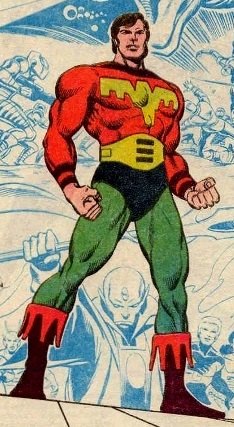
Ultra Boy is a superhero appearing in DC Comics, primarily as a member of the Legion of Super-Heroes in the 30th and 31st centuries. He gained his powers after being eaten by a whale-like beast in space and being exposed to large amounts of radiation while inside. His real name is derived from the Biblical figure Jonah, who also survived being swallowed by a "large fish".

The Inferior Five are a parody superhero team appearing in books by the American publisher DC Comics. Created by writer E. Nelson Bridwell and artist Joe Orlando, the team premiered in the DC Comics title Showcase #62.

The Composite Superman is a supervillain, an enemy of Superman and Batman. There have been several versions of the character; the original version first appeared in World's Finest Comics #142 and was created by Edmond Hamilton and Curt Swan.

Otto Oscar Binder was an American author of science fiction and non-fiction books and stories, and comic books. He is best known as the co-creator of Supergirl and for his many scripts for Captain Marvel Adventures and other stories involving the entire superhero Marvel Family. He was prolific in the comic book field and is credited with writing over 4,400 stories across a variety of publishers under his own name, as well as more than 160 stories under the pen-name Eando Binder.

The Bizarro World is a fictional planet appearing in American comic books published by DC Comics. Introduced in the early 1960s, Htrae is a cube-shaped planet, home to Bizarro and companions, all of whom were initially Bizarro versions of Superman, Lois Lane and their children. Later, other Bizarros were added. Among them was Batzarro, the World's Worst Detective.
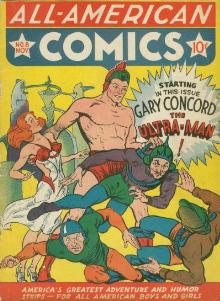
Ultra-Man is the name of two fictional comic-book superheroes, father and son, that first appeared during the 1940s, the period fans and historians call the Golden Age of comic books. Both were characters of All-American Publications, which merged, in 1946, with DC Comics-predecessor National Periodical Publications.
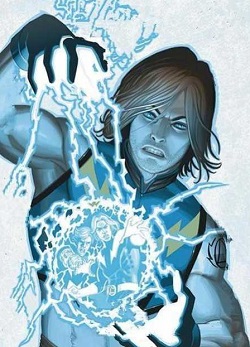
Garth Ranzz, also known as Live Wire and Lightning Lad, is a superhero appearing in media published by DC Comics, usually those featuring the Legion of Superheroes, a 30th and 31st century group of which he is a founding member. He has the superhuman ability to generate electricity, usually in the form of lightning bolts.

The character of Superman was created by Jerry Siegel and Joe Shuster, and has been continually published in a variety of DC Comics book titles since its premiere in 1938. There have been several versions of Superman over the years, both as the main hero in the stories as well as several alternative versions.
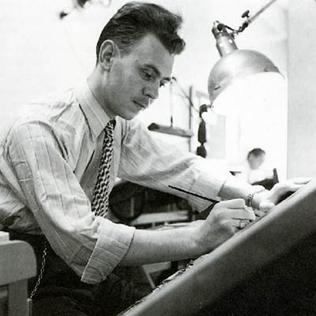
James Winslow "Win" Mortimer was a Canadian comic book and comic strip artist best known as one of the major illustrators of the DC Comics superhero Superman. He additionally drew for Marvel Comics, Gold Key Comics, and other publishers.
Insect Queen is the name of several fictional characters appearing in American comic books published by DC Comics.
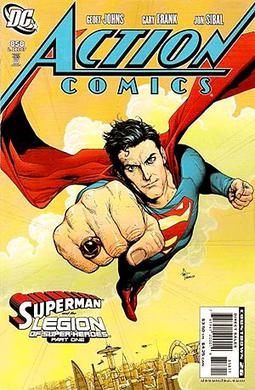
"Superman and the Legion of Super-Heroes" is a 2007 comic book DC Comics story arc written by Geoff Johns, illustrated by Gary Frank, which features the character Superman and the return of the pre-"Crisis on Infinite Earths" Legion of Super-Heroes. It ran in Action Comics #858–863, this arc marked Geoff Johns' debut as a solo writer on Action, having previously written alongside Kurt Busiek and Richard Donner.

"Superduperman" is a satirical story by Harvey Kurtzman and Wally Wood that was published in the fourth issue of Mad. Lampooning both Superman and Captain Marvel, it revolutionized the types of stories seen in Mad, leading to greatly improved sales. Writers such as Alan Moore have cited this story as an influence.
